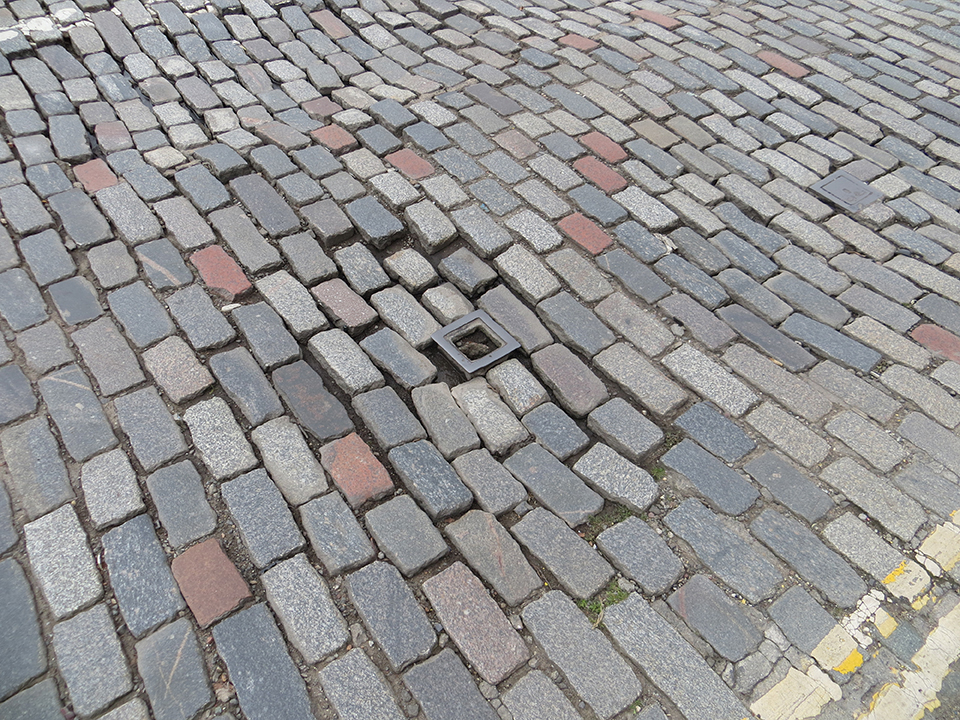It had begun to look as if revisions to BS 7533 for pavements constructed with natural stone or concrete pavers would never be completed. But the different interests have finally reached agreement and the revised standard should be out for comment shortly.
Barring any last minute problems, the first part of the revision of BS 7533 for the use of natural stone or concrete pavers should be posted on the BSI website for public comment any day now.
It had not yet been posted as this was written, so we cannot provide a link to the website. But if you want to see it and cannot find it on the BSI website, keep an eye on this website and we will post it here when it is available.
BS 7533 as it stood had 13 parts. It is now coming down three, which have been given a new numbering system to avoid any confusion. The part that should by now be out for public consultation is designated part 101, which covers design issues, involving guidance not just about the surface but also the sub-structure from hardcore to the laying course and joint filling material.
It replaces five of current parts (1,2,8,10 and 12). The intention is to follow it in due course with part 102, which will deal with installation, and then part 103, which will deal with sustainable drainage systems (SuDS) to tackle issues of flooding, including permeable pavements. That is currently covered in part 13.
With flood warnings being issued again across much of England in January it seems sensible to design flood alleviation into landscaping projects, especially as global warming is only going to make flooding even more likely in the years ahead.
Last year was nominally the second warmest on record and the decade to the end of last year was the hottest since records began in 1850.
The HadCRUT5 global temperature series, produced by the Met Office, University of East Anglia and UK National Centre for Atmospheric Science, shows that the average temperature of the world as a whole for 2020 was 1.28°C (plus or minus 0.08°C) above the average over the period 1850-1900. And that is in spite of the cooling effect of La Niña. The warmest year of all was 2016, when temperatures were elevated by El Niño conditions, which can increase global temperatures by around 0.2°C.
More than a decade ago it had been planned to make SuDS planning compulsory throughout the UK with the passing of the Flood & Water Management Act 2010. But while provisions in the Act have been implemented by the devolved governments of Scotland and Wales, they have not been implemented in England.
Even so, planning applications (except for the smallest) are supposed to include water management proposals, although they often don’t.
The Ofwat Code for Adoption of Sewers, which replaced the Sewers for Adoption guidance in April last year, was supposed to make it easier for water and sewerage companies (collectively known as WaSCs) to adopt SuDS as sewers.
The point is that developers don’t like SuDS systems because they need to be maintained and the maintenance of them is not free. Developers do not want to be saddled with the ongoing cost. But neither do some of the WaSCs, although the reaction is not universal. Some have seen taking responsibility for SuDS as a relatively inexpensive way of tackling flooding.
The lack of clarity about SuDS in England means that while it should be an integral part of the initial design of schemes, it is usually at best an afterthought, if it gets a look in at all.
SuDS is also showing all the signs of being an afterthought in the revision of BS 7533.
The route to the revision so far achieved to the design issues has not been easy.
Natural stone has increased its share of hard landscaping significantly since the last decade of the 20th century, when copious quantities of low price Indian and Chinese (in particular) sandstone and granite started making their way into Britain.
As a result, the once dominant cement product manufacturers, the clay product manufacturers and the natural stone companies found it difficult to agree on the revisions that needed to be made to BS 7533.
While the different interests might not exactly have been looking for changes that would benefit their particular product group, they were keen the changes should not convey commercial advantages to any of the other product categories, or at least that they should not disadvantage their own product group.
The different interests came together to start negotiating the revision of the standard in 2012. Four years later the process had almost ground to a halt. It was given new impetus in 2017 when Tim Yates of BRE was appointed to chair the review group. It has taken a while, but he seems to have brought some unity – although when a draft of the revision was put out to members there were some 250 comments submitted.
The hope is that now it is out for public comment there might be fewer responses because all the issues have been dealt with.
Tim says: “It has been a challenging task to draw together the different parts of BS 7533 and the views of the stakeholders, but we believe the effort will have been worthwhile.
“There has been a strong input from end users, and this has been invaluable in drafting a document that is technically correct and supports the use of modular paving.”
The principal changes involve the collation of the various pavement materials available on the market today and sets out a new selection and design process for each so that their use for public and private sector projects is simplified and encouraged.
The Standard also takes on board the changes to highway pavement design more generally over the past 10 to 15 years, so this new document, which consolidates so many parts of the standard as it currently exists, can provide definitive best practice.
The idea of consolidating these five parts of the standard into one coherent whole has been welcomed by Stone Federation Great Britain and its Landscape Forum, one of its category specific focus groups.
The Group had been planning a visit to Sheffield last year led by Zac Tudor, the architect who designed Tudor Square, to which he has given his family name, among other projects in the £130million Heart of the City programme that ran from 2004 to 2016 (although it was so successful it is continuing now as Heart of the City II).
The square, like many of the landscapes that hold the 12 areas comprising Sheffield City Centre together, makes extensive use of Johnsons Wellfield Quarry Group’s Crosland Hill sandstone, worked to the architect’s designs by the quarry company’s eight robots, without which the project could have been too expensive to have been carried to the same degree of finesse.
JWQ’s Crosland Hill stone is also being used extensively on Sheffield’s 140,000m2 Heart of the City II project currently transforming another part of the city centre into a dynamic mixed-use district that will help attract more jobs and investment, and continue making Sheffield an even more pleasant and rewarding place to live and work.
The project around Charter Square uses the stone in a variety of forms, from raw quarry blocks to precisely dimensioned steps to make the most of the many ways stone can be used and presented.
Projects like this, as well as an increasing appreciation of natural stone by the 25million or so households in the UK, helped keep suppliers of both indigenous and imported stone for hard landscaping busy last year.
Although most companies had a few weeks where they were effectively, if not entirely, closed during the first lockdown in March and April, work quickly picked up after that and stone imports returned to normal levels, as is apparent from the graphs on page 24.
They show imports of stone as setts, kerbs and flagstones for hard landscaping as measured by HMRC from taxation, essentially VAT. That does not represent all the imported stone used for hard landscaping. For example, huge amounts of granite have been imported for coastal erosion and flood defences in recent years. It might be considered as hard landscaping, but it is not included in the category by HMRC.
Also, many of the companies that were once purely stone suppliers now sell a variety of stone-look porcelain and other products as well, which makes it even harder to estimate the size of this sector in the marketplace. Nevertheless, the figures are comparable over time and present a reasonable snapshot of trends.
At the end of 2019 companies were concerned about the impact of Britain entering the Brexit transition period and the slow down of imports for landscaping at the end of the year was more marked than usual, although there might also have been other factors involved.
Normally more stone arrives in the spring and summer. You can see from the graphs the impact lockdown had on the importation of stone. Europe just about shut down. Stone from outside Europe (mostly Asia) was already on the seas when lockdown came to Europe and had to be delivered, although Asia also had its problems with the pandemic, of course, which impacted on shipments from the supply end, particularly from India.
The decline in the amount of imported stone arriving in the UK last year (shown on the top graph compared with previous years) is exaggerated on the graph because the 2020 figures only go up to November and will, in any case, continue to be adjusted for many months. The distortion will probably be even greater than usual for 2020 because of the concessions made by HMRC on tax payments due to the pandemic.
Evidence of the recovery after the spring lockdown is also supplied by the latest Builders Merchants Building Index (BMBI) report. The figures also only go to the end of November but show that the value of sales by Britain’s builders’ merchants in November saw a significant increase compared with November 2019. With builders heeding the Government’s directive to keep construction sites open, sales were 9% higher than in November 2019, despite tougher Covid-19 restrictions implemented from 5 November. And leading the growth was landscaping, up 29.3% on November 2019.
A nationally representative research study by mobile-based billing service Powered Now has found that 15% of the nation’s tradespeople are experiencing their highest level of client demand ever and 18% of householders say the pandemic has encouraged them to commence home improvement projects sooner rather than later. That is not just for the garden market, but shows a good proportion of homeowners want to improve their domestic environment as they spend more time at home.
There are no reliable figures for the production or use of indigenous stone.
A straw pole of some of stone’s major hard landscaping suppliers, of indigenous stones and imports, suggests 2020 as a whole turned out pretty well. So well for market leading Marshalls, in fact, that it repaid the £9.4million it had received from the government for furloughed staff. It has said it will also pay a final dividend to shareholders, having skipped the interim, and plans to invest more than £30million this year to increase capacity for existing product ranges, build on its sustainability (there are plans to reduce plastic packaging and install more solar panels) and boost product and digital innovation.
Marshalls has reported revenues of £469million for 2020, down 13% on the year before but with sales picking up strongly after the initial Covid lockdown.
The company says growth of the domestic garden market in the second half offset some of the decline in the public and commercial sector, although that, too, had recovered year-on-year by the fourth quarter.
Others have also reported growth of the domestic garden sector, some speculating that the craze for wooden decking in the past 20-30 years is now helping stone and hard surface sales because as the decking rots people are deciding to replace it with more durable patios and paving.
Spending more time at home during the pandemic and being deprived of some family holidays has probably also helped householders to see where improvements could be made and meant they had spare cash to pay for them. They possibly also had more time to spend watching the wide selection of garden makeover programmes to choose from on the television.
The trend for continuing interiors into exteriors with matching flooring and paving and minimal barriers between the two has also helped, as have the garden kitchens that have become de rigueur among the urban elite who now scoff at simple barbeques.
The combination of factors has led many of the product suppliers to feel bullish about the year ahead, especially with the roll out of the Covid vaccines across the world. However, importers were complaining at the start of the year about continuing delays at the docks making it difficult to get stock into the UK, some saying that the end of the Brexit transition period had exacerbated the problem.
It is not only getting through the docks that is causing delays. It is also proving difficult to get shipments on to boats in the first place. As one importer told NSS: “Even if you can get a container there’s no ships to put it on.” With demand exceeding supply, the price of shipping has been rising rapidly.
Another major supplier of stone for hard landscaping is CED Stone Group, which is also anticipating building on its success of the past year in the year ahead. It plans to expand its network of depots (currently six with an office in New York), increase its product lines and strengthen its team of people with the help of an £8.5million refinancing package it has secured through specialist business advisory firm FRP, including new funding from Leumi ABL.
Giles Heap, managing director of CED Stone Group, which celebrated its 40th anniversary in 2018, said: “We are now well placed to really push on in 2021 and build on the success and resilience we’ve shown in 2020. Expanding our depot network, as well as our product lines, offers an opportunity to grow our already 80-strong team and ensure the business continues to thrive for another 40 years.” He said FRP had exceptional understanding of the lending market, which had been invaluable.
Although the year ahead appears less predictable than usual, the Brexit trade deal with Europe and the reaction to the pandemic to date have given many a measure of optimism for the future.
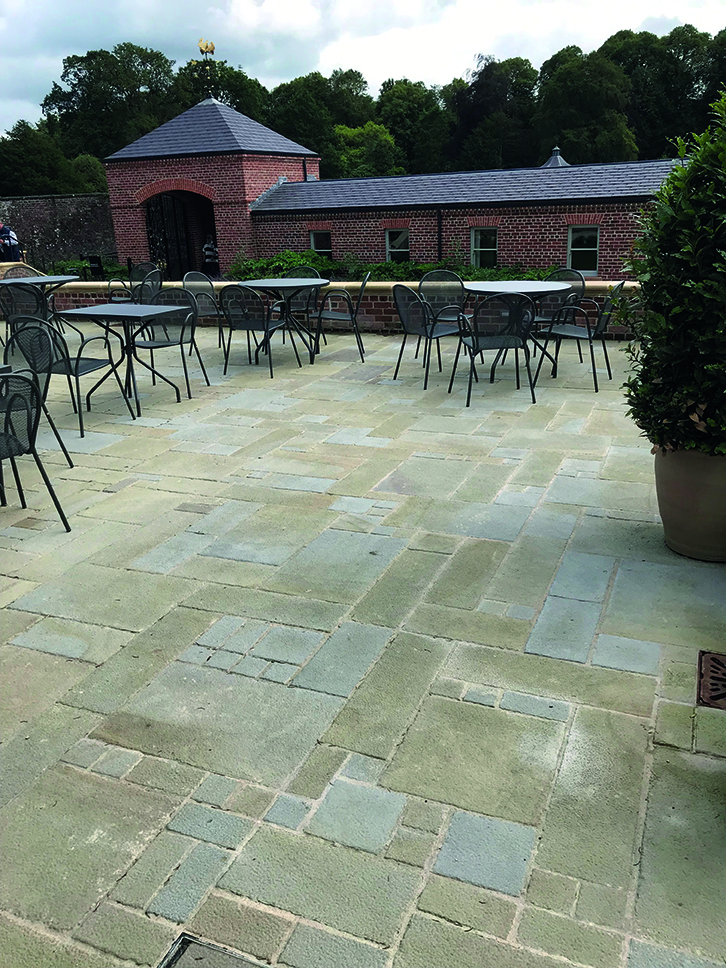
The picture above shows mixed colour Forest of Dean Stone Firms pennant paving supplied to Hillsborough Castle in Northern Ireland. In total, there were 500m2 supplied, all bespoke sizing and finishes. The project won the ‘Excellence in Heritage and Culture’ category of the Landscape Institute Awards of 2020.
Forest of Dean Stone Firms (FoD), now part of the Lovell Stone Group but retaining its own identity, supplied the stone via Hardscape, the hard landscaping material supplier that has six centres in the British Isles, including one in Ireland.
Hillsborough Castle is an 18th Century home set in 98 acres of grounds. It is the royal residence in Northern Ireland and official home to the Secretary of State. But some of the grounds around the main building had become a forgotten backdrop, with large sections overgrown and in disrepair.
In 2014, Historic Royal Palaces took over the operation of Hillsborough Castle and its gardens and embarked on a major restoration project.
A £20 million investment, with two years of design and two more of construction, and the doors have been opened to the public, reintroducing a vibrant landscape and giving the castle and gardens a valuable future.
The Paul Hogarth Company developed the landscape design in consultation with garden designers Catherine Fitzgerald and Mark Lutyens. The work included the restoration of the 18th century walled garden and the creation of the Lost Garden alongside a previously overgrown stream. There are new cascades, bridges and follies. There’s a formal State Entrance and a new vehicle park accommodating tourist coaches and up to 1,000 cars.
Local tradespeople and traditional construction techniques were used to achieve the character and quality fitting for this historic site, while at the same time implementing modern sustainable construction methods to minimise the impact of the scheme on the environment.
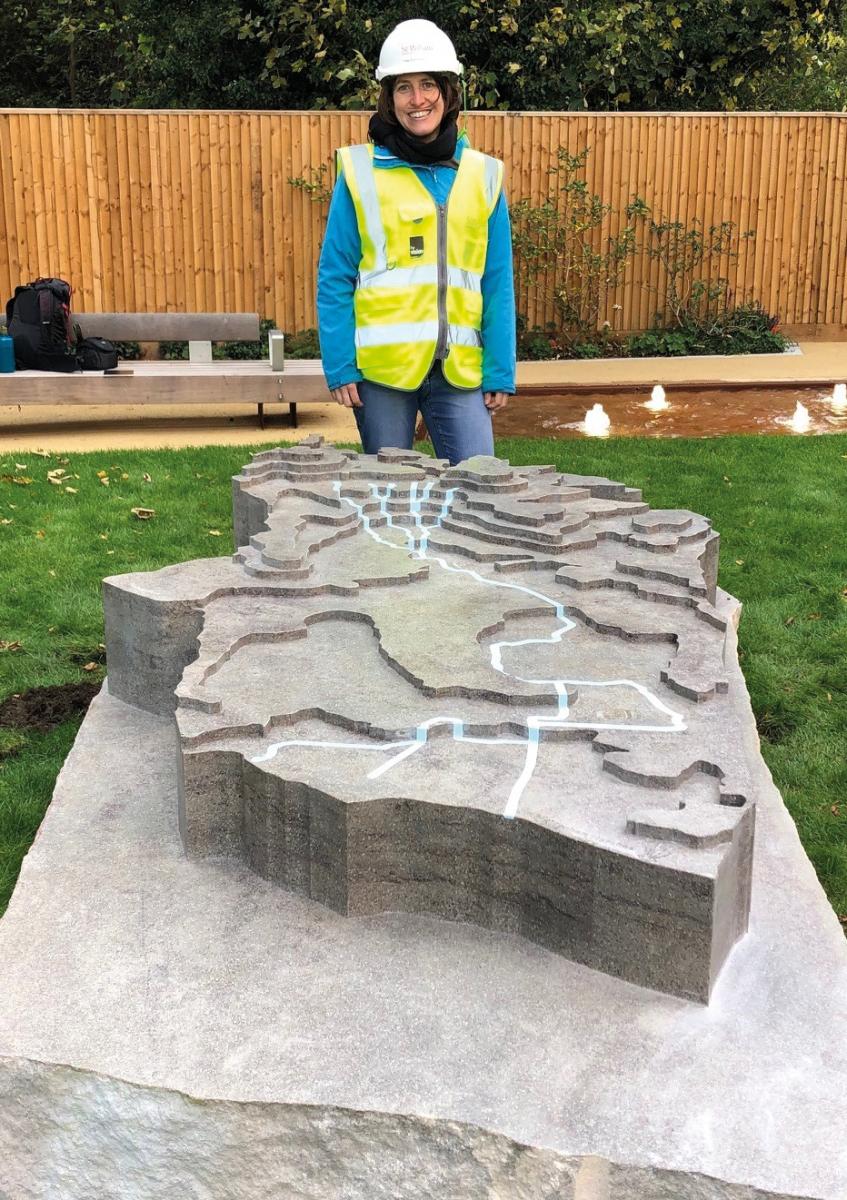
Rachael Champion is pictured on the right with the artwork she designed that shows the course of the Moselle Brook that flows unnoticed through Harringay. The other pictures show the artwork in production at stoneCIRCLE’s workshop in Basingstoke.
A river mapped in limestone – 'Course and Flow' by Rachael Champion
'Course and Flow' is an artwork by Rachael Champion commissioned by St William Property Developers and Dallas-Pierce-Quintero, the architects working with the developer on the Hornsey Park Clarendon development in the Haringey Heartlands regeneration scheme, which is creating 1,700 homes, a new open space and new employment opportunities in the north London Borough of Haringey.
Rachael Champion’s design was fabricated by stoneCIRCLE at its workshop in Basingstpoke, Hampshire, from a four ton block – the largest size available at the time – of Mandale Derbyshire Fossil limestone .
The inspiration for the design was the Moselle Brook, a hidden stream that flows through the borough of Haringey. Rachel envisaged a topographical stone map with the course of the river delineated in blue resin set into the stone.
Words, phrases, and places relating to the Moselle and its route are carved into the block’s surface, creating a feeling of its social history and the context in which it exists.
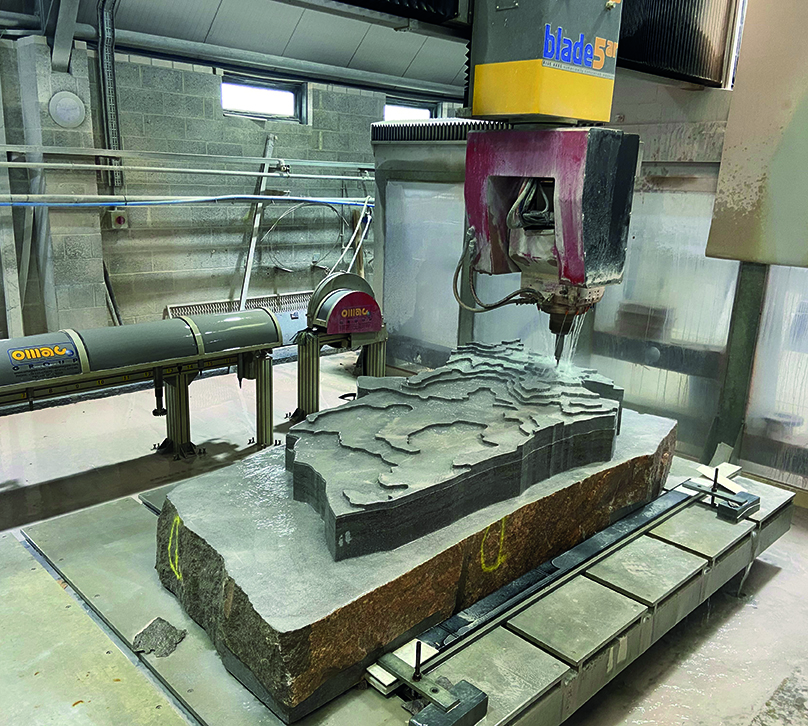 The artist is interested in the juxtaposition of nature and the built environment, and deliberately left the bore holes from the quarry and the registration marks from the stoneCIRCLE Omag CNC machinery that worked the stone visible in the finished piece.
The artist is interested in the juxtaposition of nature and the built environment, and deliberately left the bore holes from the quarry and the registration marks from the stoneCIRCLE Omag CNC machinery that worked the stone visible in the finished piece.
The sides of the block were also left untouched, encouraging residents and visitors to use the artwork as a seating area and to highlight the physical transformation that the stone has undergone.
It took stoneCIRCLE three weeks to complete the work. The block spent a week on the five-axes Blade 5, before being transferred to the workshop for the designs and inscriptions to be added and the routed river channel to be filled with blue epoxy resin.
The finished work is 65cm high, 110cm wide and 265cm long. To make it easier to transport, the underside was milled out, reducing the weight to approximately 2,500kg and making it easier to crane into place ready to be inaugurated by the Mayor of Haringey at an appropriately socially distanced ceremony in October.
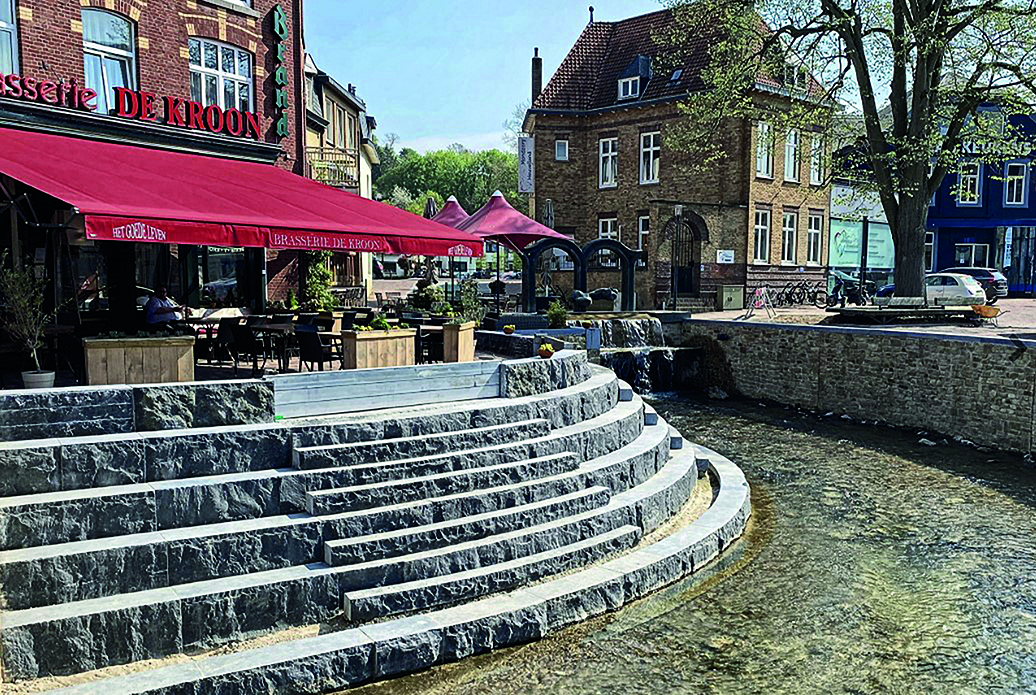
Pictured above is the town of Gulpen-Wittem in the Netherlands following last year’s riverside upgrade using Kilkenny Blue Limestone from McKeon Stone. The stone was supplied through McKeon’s Dutch customer, Stonebase.
The project called for split face stone from 500mm to 700mm thick, typically 1200mm long and 400mm wide, with many of the stones curved.
The stone was supplied as paving and steps along with 200m of 120mm wall capping for the walls along the banks of the river.
McKeon Stone supplied 120 tons of its Kilkenny Blue limestone for the project. And while McKeon has a stone splitter, it can only work up 500mm thicknesses, so for much of the project it was a matter of using plugs and feathers with mallets and pitchers – and strong arms.

Growth of the use of stone in the domestic garden market in the second half of last year buoyed the sector. The project pictured here is in Surrey. Nationwide hard landscaping materials supplier London Stone, which continued its expansion last year with the acquisition of Chelmer Valley Brick Co Ltd in Essex, supplied the project’s 400m2 of Jura Beige sawn limestone, sandblasted and lightly brushed for a smooth surface.
The garden was designed by Pollyanna Wilkinson Garden Design and built by Burnham Landscaping Ltd. It has a multi-level terraced areas for entertaining and relaxing, a swimming pool surround, and sunken patio.
London stone supplied over 100 linear metres of bullnosed step treads to the scheme. They were also used as pool coping stones. The main paving areas have 900 x 600 x 25mm calibrated flags, laid in a stretcher bond to highlight the contemporary nature of the scheme.
The team from Burnham Landscaping that laid the hard landscaping used enhanced PPE and social distancing measures as the build continued throughout the Covid-19 pandemic. The Jura Beige limestone used is a premium quality amorphous Jurassic chalkstone from Upper Bavaria, Germany, renowned for its fossilised ammonite features that are highlighted by sawing.
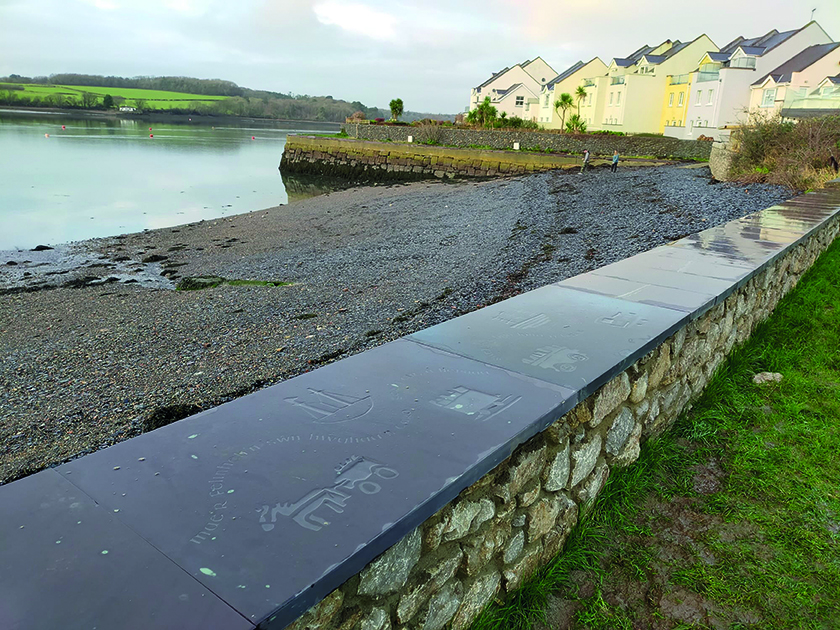
The project pictured above at Beach Road in Felinheli, Wales, is essentially flood protection works, but while it was being carried out it was decided it offered an opportunity to improve the visual aspect of the road as well. The project is a £700,000 scheme jointly funded by Gwynedd County Council and the Welsh Government.
The works are intended to protect homes and businesses from flooding at high tides and to cope with rising sea levels. The project included the building of a new sea wall and improved drainage.
The wall is concrete, mainly faced with local Anglesey limestone, but sections of it have been designed so that the local population and visitors can sit on it and enjoy views out across the Menai Straits to Anglesey.
Welsh Slate was chosen as the ideal coping material for this section because it is smooth to sit on, could be carved and inscribed (as some of it has been) and will survive pretty much whatever the weather and sea throw at it, offering enduring beauty ideal for a marine environment.
OBR Construction of Talwrn, Anglesey, fitted 174 copings of 450mm x 700mm x 50mm in Penrhyn Heather with a honed finish and drip grooves from Welsh Slate, and two units 1200mm x 700mm x 50mm that have been engraved.
The words relating to the history of Feliheli on the slate are by local poet Osian Owen. Gwynedd Council’s in-house engineering consultancy team, YGC, combined the poetry with images created under the guidance of artist Eleri Jones in conjunction with pupils from years five and six at Ysgol y Felinheli school to produce a digital design for the copings. The designs were cut into the slate by local company Llechi’r Ddraig Cyf of Chwilog.
The project was funded by the National Lottery Heritage Fund as part of a bid to secure World Heritage status for the Slate Landscape of North-West Wales. UNESCO will announce which World Heritage bids have been successful in the summer.

